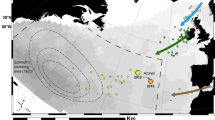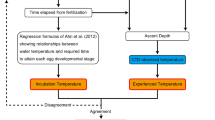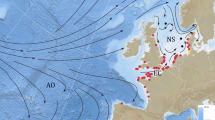Tiny transparent larvae of the Japanese eel collected in the open ocean reveal a strategic spawning site.
Abstract
Discoveries of the larvae of the European and American eels, Anguilla anguilla and A. rostrata, in the Sargasso Sea1,2 and of the Japanese eel, A. japonica, in the Philippine Sea3 indicate that these freshwater eels migrate thousands of kilometres into the open ocean to spawn. Here we pinpoint a spawning location for Japanese eels after genetically identifying newly hatched larvae that we collected from the site. The restricted size of this spawning area ensures that the eel larvae enter a particular current that transports them to the freshwater areas in east Asia where they mature, and it also prevents them from being carried southwards away from their species range by a different local current.
Similar content being viewed by others
Main
It has been suggested that changes in oceanic conditions4 are contributing to the recent drastic decline of anguillid eels worldwide5, by disrupting their spawning areas and the transport of their larvae (leptocephali)4. But little is known about such spawning areas. On the basis of data collected on leptocephali over almost 50 years and analysis of their hatching dates, we have proposed that the Japanese eel spawns near seamounts west of the Mariana Islands (14–17° N, 142–143° E), close to the time of the new moon6. We have now verified the location and timing of spawning by Japanese eels after collection and analysis of the newly hatched pre-leptocephali.
During research cruise KH-05-1 aboard RV Hakuho Maru, we collected and genetically identified 130 pre-leptocephali (size, 4.2–6.5 mm) and 60 leptocephali (11.7–18.4mm) of the Japanese eel in the region of the North Equatorial Current in June 2005. The pre-leptocephali were collected around 14° N, 142° E, to the west of the Suruga Seamount in the southern part of the West Mariana Ridge (Fig.1).
Left, catches of the Japanese eel, Anguilla japonica, in the western North Pacific Ocean between 1961 and 2002 (n=2,418; ref. 6); yellow circles, sites where leptocephali larger than 7 mm were collected. Metamorphosing leptocephali (blue triangles) and oceanic glass eels (green squares) were also found. Black dots, sites where no larvae were found. Right, eel catches in the western North Atlantic Ocean (1913–85; ref. 2). Shaded areas, sites where leptocephali (⩽10 mm in size) of each species were collected2. Red squares mark collection sites of pre-leptocephali (⩽7 mm) of the Japanese eel (left) or of both Atlantic eel species2 (right). NEC, North Equatorial Current. Inset, distribution and number of Japanese eel pre-leptocephali (⩽7 mm; green circles) and leptocephali (>7 mm; yellow circles) collected during the time of the new moon in June 2005. Red triangles, seamounts. White circles, stations where no Japanese eel leptocephali were found.
Some pre-leptocephali were identified as A. japonica on board by real-time polymerase chain reactions7; this identification was later confirmed by DNA sequencing of additional specimens8. (For details, see supplementary information.) The larvae were collected on the day of the new moon and for two days afterwards. They were at various stages of development: some had unpigmented eyes and no teeth, others had pigmented eyes, early teeth and jaws (Fig. 2). Daily growth rings of calcium mineralization in ‘ear stones’ known as otoliths showed that the eels had hatched 2 to 5 days previously, indicating that spawning had occurred about 4 days before the new moon.
a, Head regions of early-stage larvae with no teeth, jaws or eye pigmentation; b, some larvae show early eye pigmentation; c, some have early teeth but no jaws; d, others have teeth that are more developed and early jaws. Larva lengths in a–d are 5.0, 4.7, 5.2 and 4.2 mm, respectively. Scale bar, 1 mm.
We have identified a precise spawning location by collecting newly hatched pre-leptocephali. The area seems to be much smaller than the spawning area estimated for the Atlantic eels (Fig. 1). It is located at an optimum latitude for the leptocephali to enter the Kuroshio Current that flows north towards the eels' habitat areas in east Asia. It seems that spawning occurs in a narrow range of latitudes because otherwise leptocephali would not find the northward flow and might instead enter the Mindanao Current, which flows southwards to places where there are no Japanese eels4,6.
References
Schmidt, J. Smithson. Inst. Annu. Rep. 1924, 279–316 (1925).
McCleave, J. D., Kleckner, R. C. & Castonguay, M. Am. Fish. Soc. Symp. 1, 286–297 (1987).
Tsukamoto, K. Nature 356, 789–791 (1992).
Kimura, S., Inoue, T. & Sugimoto, T. Fish. Oceanogr. 10, 51–60 (2001).
Dekker, W. Fisheries 28, 28–30 (2003).
Tsukamoto, K. et al. Environ. Biol. Fish. 66, 221–229 (2003).
Watanabe, S. et al. Mar. Biotechnol. 6, 566–574 (2004).
Aoyama, J. et al. Mar. Ecol. Progr. Ser. 188, 193–200 (1999).
Author information
Authors and Affiliations
Corresponding author
Ethics declarations
Competing interests
The author declares no competing financial interests.
Supplementary information
Rights and permissions
About this article
Cite this article
Tsukamoto, K. Spawning of eels near a seamount. Nature 439, 929 (2006). https://doi.org/10.1038/439929a
Received:
Accepted:
Published:
Issue Date:
DOI: https://doi.org/10.1038/439929a
This article is cited by
-
Regional differences in oceanic migratory behavior of Japanese silver eel in waters with different vertical temperature gradients
Animal Biotelemetry (2023)
-
Seasonally-reversed trends in the subtropical Northwestern Pacific linked to asymmetric AMO influences
Scientific Reports (2023)
-
North Equatorial Current and Kuroshio velocity variations affect body length and distribution of the Japanese eel Anguilla japonica in Taiwan and Japan
Scientific Reports (2022)
-
Active swimming and transport by currents observed in Japanese eels (Anguilla japonica) acoustically tracked in the western North Pacific
Scientific Reports (2022)
-
18S rRNA gene sequences of leptocephalus gut contents, particulate organic matter, and biological oceanographic conditions in the western North Pacific
Scientific Reports (2021)
Comments
By submitting a comment you agree to abide by our Terms and Community Guidelines. If you find something abusive or that does not comply with our terms or guidelines please flag it as inappropriate.





